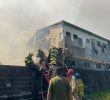DAVAO CITY—Three problems cropped up during the mock elections at the Generoso Elementary School in Bago Aplaya village in Davao City on February 6, Saturday.
The first problem occurred when a ballot jammed inside the Precinct Count Optical Scanning machine (PCOS). Upon checking, it was found out that a portion of the ballot was slightly folded. A technician from the Smartmatic took the ballot out and restarted the machine.
It took around three to five minutes to correct the whole process.

People flock around the PCOS machine as it prints the Initialization Report (IR) during the mock election at the Generoso Elementary School in Bago Aplaya, Davao City. (photo by Karlos Manlupig)
First district election officer Danilo Cullo said the Commission on Elections (Comelec) plans to assign one or two technicians in each polling place during the actual voting in May. But each polling place can have more than five precincts for each cluster accommodating up to 1,000 voters. This means that voters will have to line up and wait for the technicians to fix the problem when a similar problem crops up in each of the five precincts.
The second problem occurred when the machine did not recognize one ballot inserted for counting and rejected it. The machine recognized the ballot only after its reverse side was scanned. This second problem underscored the need for the Board of Election Inspectors (BEIs) or anybody who will oversee the voting process in the May 2010 polls because one who is not familiar with the technology might easily discard the ballot rejected by the machine as invalid. The teachers’ group Kamkem-Act in Southern Mindanao earlier expressed anxiety over the delayed poll automation training for the teachers who will serve as BEIs during the election.

FALL IN LINE. People taking part in the mock elections patiently wait for their turn to experience first-hand how the Automated Election System works. Armed police and military personnel are seen within the polling area. (photo by Karlos Manlupig)
Comelec earlier moved the scheduled training for BEIs from January to March, only months before the actual elections in May.
The last problem during the mock election occurred when the machine rejected one ballot that was not properly filled because the voter checked, instead of shading, the circles near the name of the candidate of his or her choice.
The Comelec’s voters’ information campaign on poll automation system only reached 10 of the 40 barangays in the city’s first district. Davao City has over 180 barangays.
Cullo said the three problems that cropped up were “just minors”. He considered the mock elections successful.
The mock elections started at eight o’clock in the morning and ended at 10: 30 a.m. The Comelec randomly selected 50 voters out of around a thousand voters in one clustered precinct in Bago Aplaya. The voters used dummy ballots filled with names of Filipino heroes, former government officials and local bands as candidates from the national to local level.

photo by Karlos Manlupig
The PCOS machines counted the ballots after the voting. The Comelec, however, did not reveal the results. Cullo said the results were automatically transmitted to the canvassing area at the Sangguniang Panlungsod building. After the ballots were canvassed from the municipal or city levels, the Comelec sends the results to the data base in their central office.
The transmission of the votes was done using a Smart network signal. Cullo said the Comelec will have to choose from four telecommunication signals available, depending on which signal works better in the area. In areas where signals are weak, Cullo said, they will use the Broadband Global Area Network (BGAN) satellite device.
Members of the election watchdog Pagbabago! Movement for Change were also at the mock elections to monitor the conduct of the poll automation.
Another mock election was held at Alejandra Navarro Elementary School in Lasang, for the city’s second district.
The Davao City mock elections were part of the Comelec’s two-hour nationwide activity to simulate the actual voting, counting, canvassing and transmitting in the upcoming the May 10, 2010 elections. (Grace S. Uddin/ davaotoday.com)










